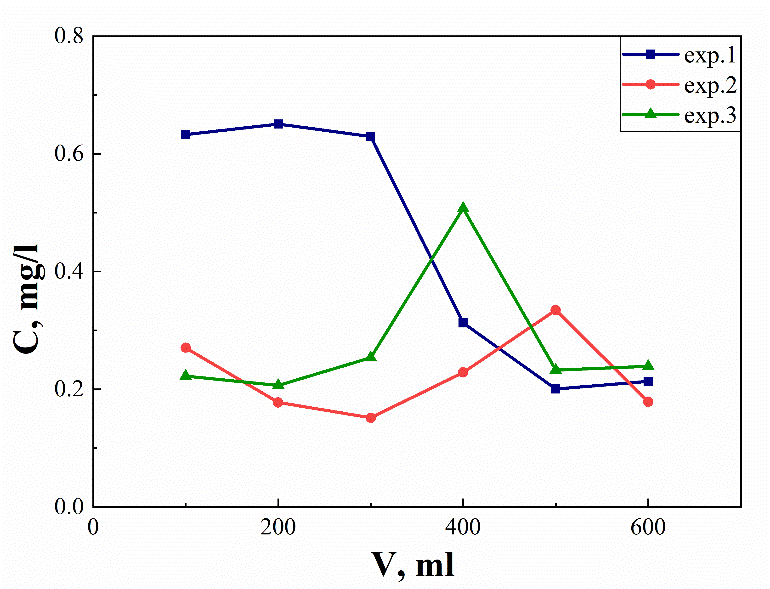
Using the mineral component of building refuse in heavy metals sorption from their mixture
Abstract
Keywords
Full Text:
PDFReferences
Perel'man AI. Geochemical barriers: theory and practical applications. Applied Geochemistry. 1986;1(6):669-80. doi:10.1016/0883-2927(86)90088-0
Maximovich N, Khayrulina E. Artificial geochemical barriers for environmental improvement in a coal basin region. Environmental Earth Sciences. 2914;72:1915-24. doi:10.1007/s12665-014-3099-7
Bogush AA, Galkova OG, Ishuk NV. Geochemical barriers to elemental migration in sulfide-rich tailings: three case studies from Western Siberia. Mineralogical Magazine. 2012;76(7):2693-707. doi:10.1180/minmag.2012.076.7.05
Zhao Q, Choo H, Bhatt A, Burns SE, Bate B. Review of the fundamental geochemical and physical behaviors of organoclays in barrier applications. Applied Clay Science. 2017;142:2-20. doi:10.1016/j.clay.2016.11.024
Nguyena TAH, Ngoa HH, Guoa WS, Zhangb J, Liangb S, Yueb QY, Lib Q, Nguyen TV. Applicability of agricultural waste and by-products for adsorptive removal of heavy metals from wastewater. Bioresource Technology. 2013;148:574-85. doi:10.1016/j.biortech.2013.08.124
Kumar PS, Ramalingam S, Abhinaya RV, Kirupha SD, Murugesan A, Sivanesan S. Adsorption of metal ions onto the chemically modified agricultural waste. Clean – Soil, Air, Water. 2012;40(2):188-97. doi:10.1002/clen.201100118
Chandrappa AK, Biligiri KP. Pervious concrete as a sustainable pavement material – Research findings and future prospects: A state-of-the-art review. Construction and Building Materials. 2016;111:262-74. doi:10.1016/j.conbuildmat.2016.02.054
Shershneva MV, Puzanova IE, Soloviova VI. Geoekologicheskii aspekt ispol'zovaniia kal'tsiisoderzhashchikh stroitel'nykh otkhodov [Geoecological aspect of the use of calcium-containing construction waste]. Proceedings of Petersburg Transport University. 2010;2:286-92. Russian.
Shershneva MV. Ispol'zovanie geozashhitnyh svojstv tverdyh othodov na transporte [Use of geoprotective properties of solid waste in transport]. Proceedings of Petersburg Transport University. 2007;3:89-95. Russian.
Shershneva MV. Estestvenno-nauchnye osnovy geozashhitnogo rezerva prirodnyh i iskusstvennyh mineralov [Natural-scientific foundations of the geoprotective reserve of natural and artificial minerals]. Proceedings of Petersburg Transport University. 2011;1:237-46. Russian.
Navarro-Blasco I, Duran A, Sirera R, Fernández JM, Alvarez JI. Solidification/stabilization of toxic metals in calcium aluminate cement matrices. Journal of Hazardous Materials. 2013;260:89-103. doi:10.1016/j.jhazmat.2013.04.048
Svatovskayaa L, Shershneva M, Baydarashvily M, Sychova A, Sychov M, Gravit M. Geoecoprotective properties of cement and concrete against heavy metal ions. Procedia Engineering. 2015;117:345-9. doi:10.1016/j.proeng.2015.08.171
Adinarayana KNV, Sasidhar P, Balasubramaniyan V. Modelling of calcium leaching and its influence on radionuclide migration across the concrete engineered barrier in a NSDF. Journal of Environmental Radioactivity. 2013;124:93-100. doi:10.1016/j.jenvrad.2013.04.009
Panin АV, Puzanova IE. Geojekologicheskie reshenija obezvrezhivanija ionov tjazhelyh metallov s pomoshh'ju othodov stroitel'noj promyshlennosti [Geoecological solutions for the neutralization of heavy metal ions using waste from the construction industry]. Proceedings of Petersburg Transport University. 2010;2:251-61. Russian.
Djegola LA, Simakova YM, Rubleva AV, Nikitina OV, Kuatalieva SB. Model’ geokhimicheskogo bar’era dlya akkumulyatsii ionov tyazhelykh toksichnykh I radioaktivnykh metallov [The geochemical barrier model for heavy, toxic and radioactive metals storage]. Estestvennye nauki [Natural Sciences]. 2009;4(29):180-3. Russian.
Levit RL, Kudryavtseva VA. Sorption of zinc, cadmium, lead and copper by mineral particulate matter. Regional Ecology. 2015;6(41):52-7. doi:10.30694/1026-5600-2019-1-5-12
Azmatova E, Myakisheva A, Tashkinova I. Theoretical and experimental justification of using construction and demolition wastes for disturbed areas rehabilitation. PNRPU Bulletin, Applied ecology. Urban development. 2016;31:110-25. doi:10.15593/2409;5125/2016.03.08
Nevedrov NP, Procenko EP, Balabina IP, Fomina MJu. Tjazhelye metally v pochvah goroda: zagrjaznenie i remediacija [Heavy metals in city soils: pollution and remediation]. Moscow: Ru-Science; 2017. 120 p. Russian.
DOI: https://doi.org/10.15826/chimtech.2021.8.1.12
Copyright (c) 2020 V. M. Yurk, O. B. Zaytsev, A. V. Zaytseva, N. A. Malahova

This work is licensed under a Creative Commons Attribution 4.0 International License.
Chimica Techno Acta, 2014–2025
eISSN 2411-1414
Copyright Notice






